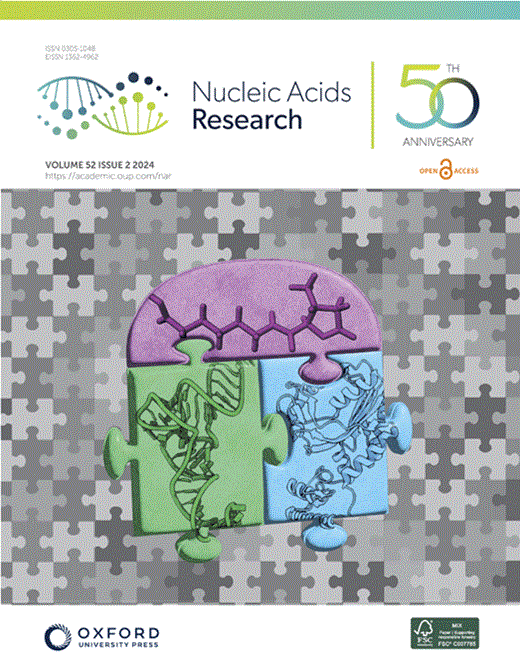MnmE-MnmG复合物的Cryo-EM结构揭示了巨大的构象变化,并为tRNA修饰机制提供了新的见解
IF 13.1
2区 生物学
Q1 BIOCHEMISTRY & MOLECULAR BIOLOGY
引用次数: 0
摘要
MnmE和MnmG形成一种保守的蛋白质复合物,负责在几种转移rna (trna)的摆动尿嘧啶上添加5-羧甲基胺甲基(cmnm5)基团。在该复合体中,这两种蛋白紧密合作催化tRNA修饰反应,该反应涉及甘氨酸作为底物以及三种不同的辅助因子,FAD和NADH结合MnmG和亚甲基四氢叶酸(5,10- ch2 - thf)结合MnmE。没有MnmEG复合物的结构,这些底物和辅助因子如何以协调一致的方式聚集在一起仍然是一个谜。先前的小角度x射线散射数据表明,MnmE (α2)和MnmG (β2)同型二聚体可以采用α2β2或α4β2配合物,这取决于MnmE的核苷酸状态。本文报道了MnmEG配合物α2β2和α4β2低聚态的低温电镜结构。这些结构揭示了MnmE在与MnmG相互作用时发生了巨大的构象变化,形成了不对称的MnmE二聚体。特别是,MnmE的功能重要的c端螺旋从MnmE的5,10- ch2 - thf结合袋中迁移到MnmG的fad结合袋中,从而提示了活化亚甲基从一个活性位点转移到另一个活性位点的机制。总之,这些发现为mnmeg催化的反应提供了重要的新见解。本文章由计算机程序翻译,如有差异,请以英文原文为准。
Cryo-EM structures of the MnmE–MnmG complex reveal large conformational changes and provide new insights into the mechanism of tRNA modification
MnmE and MnmG form a conserved protein complex responsible for the addition of a 5-carboxymethylaminomethyl (cmnm5) group onto the wobble uridine of several transfer RNAs (tRNAs). Within this complex, both proteins collaborate intensively to catalyze a tRNA modification reaction that involves glycine as a substrate in addition to three different cofactors, with FAD and NADH binding to MnmG and methylenetetrahydrofolate (5,10-CH2-THF) to MnmE. Without structures of the MnmEG complex, it remained enigmatic how these substrates and co-factors can be brought together in a concerted manner. Prior small angle X-ray scattering data suggested that the MnmE (α2) and MnmG (β2) homo-dimers can adopt either an α2β2 or α4β2 complex, depending on the nucleotide state of MnmE. Here, we report the cryo-EM structures of the MnmEG complex in the α2β2 and α4β2 oligomeric states. These structures reveal that MnmE undergoes large conformational changes upon interaction with MnmG, resulting in an asymmetric MnmE dimer. In particular, the functionally important C-terminal helix of MnmE relocates from the 5,10-CH2-THF-binding pocket of MnmE to the FAD-binding pocket of MnmG, thus suggesting a mechanism for the transfer of an activated methylene group from one active site to the other. Together, these findings provide crucial new insights into the MnmEG-catalyzed reaction.
求助全文
通过发布文献求助,成功后即可免费获取论文全文。
去求助
来源期刊

Nucleic Acids Research
生物-生化与分子生物学
CiteScore
27.10
自引率
4.70%
发文量
1057
审稿时长
2 months
期刊介绍:
Nucleic Acids Research (NAR) is a scientific journal that publishes research on various aspects of nucleic acids and proteins involved in nucleic acid metabolism and interactions. It covers areas such as chemistry and synthetic biology, computational biology, gene regulation, chromatin and epigenetics, genome integrity, repair and replication, genomics, molecular biology, nucleic acid enzymes, RNA, and structural biology. The journal also includes a Survey and Summary section for brief reviews. Additionally, each year, the first issue is dedicated to biological databases, and an issue in July focuses on web-based software resources for the biological community. Nucleic Acids Research is indexed by several services including Abstracts on Hygiene and Communicable Diseases, Animal Breeding Abstracts, Agricultural Engineering Abstracts, Agbiotech News and Information, BIOSIS Previews, CAB Abstracts, and EMBASE.
 求助内容:
求助内容: 应助结果提醒方式:
应助结果提醒方式:


